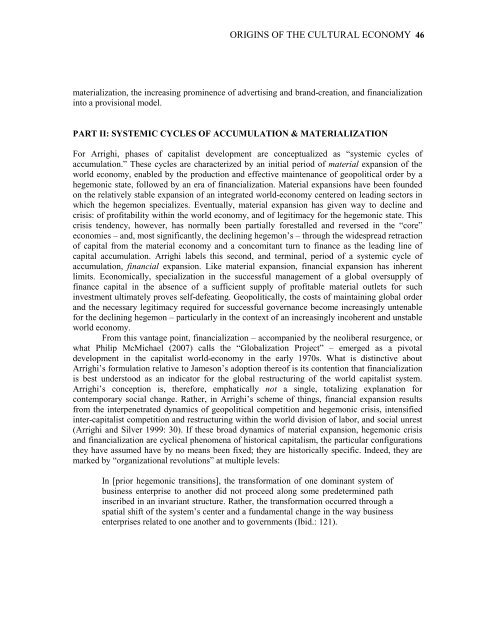Entire Volume 17 issue 1 - Journal of World-Systems Research ...
Entire Volume 17 issue 1 - Journal of World-Systems Research ...
Entire Volume 17 issue 1 - Journal of World-Systems Research ...
Create successful ePaper yourself
Turn your PDF publications into a flip-book with our unique Google optimized e-Paper software.
ORIGINS OF THE CULTURAL ECONOMY 46<br />
materialization, the increasing prominence <strong>of</strong> advertising and brand-creation, and financialization<br />
into a provisional model.<br />
PART II: SYSTEMIC CYCLES OF ACCUMULATION & MATERIALIZATION<br />
For Arrighi, phases <strong>of</strong> capitalist development are conceptualized as “systemic cycles <strong>of</strong><br />
accumulation.” These cycles are characterized by an initial period <strong>of</strong> material expansion <strong>of</strong> the<br />
world economy, enabled by the production and effective maintenance <strong>of</strong> geopolitical order by a<br />
hegemonic state, followed by an era <strong>of</strong> financialization. Material expansions have been founded<br />
on the relatively stable expansion <strong>of</strong> an integrated world-economy centered on leading sectors in<br />
which the hegemon specializes. Eventually, material expansion has given way to decline and<br />
crisis: <strong>of</strong> pr<strong>of</strong>itability within the world economy, and <strong>of</strong> legitimacy for the hegemonic state. This<br />
crisis tendency, however, has normally been partially forestalled and reversed in the “core”<br />
economies – and, most significantly, the declining hegemon’s – through the widespread retraction<br />
<strong>of</strong> capital from the material economy and a concomitant turn to finance as the leading line <strong>of</strong><br />
capital accumulation. Arrighi labels this second, and terminal, period <strong>of</strong> a systemic cycle <strong>of</strong><br />
accumulation, financial expansion. Like material expansion, financial expansion has inherent<br />
limits. Economically, specialization in the successful management <strong>of</strong> a global oversupply <strong>of</strong><br />
finance capital in the absence <strong>of</strong> a sufficient supply <strong>of</strong> pr<strong>of</strong>itable material outlets for such<br />
investment ultimately proves self-defeating. Geopolitically, the costs <strong>of</strong> maintaining global order<br />
and the necessary legitimacy required for successful governance become increasingly untenable<br />
for the declining hegemon – particularly in the context <strong>of</strong> an increasingly incoherent and unstable<br />
world economy.<br />
From this vantage point, financialization – accompanied by the neoliberal resurgence, or<br />
what Philip McMichael (2007) calls the “Globalization Project” – emerged as a pivotal<br />
development in the capitalist world-economy in the early 1970s. What is distinctive about<br />
Arrighi’s formulation relative to Jameson’s adoption there<strong>of</strong> is its contention that financialization<br />
is best understood as an indicator for the global restructuring <strong>of</strong> the world capitalist system.<br />
Arrighi’s conception is, therefore, emphatically not a single, totalizing explanation for<br />
contemporary social change. Rather, in Arrighi’s scheme <strong>of</strong> things, financial expansion results<br />
from the interpenetrated dynamics <strong>of</strong> geopolitical competition and hegemonic crisis, intensified<br />
inter-capitalist competition and restructuring within the world division <strong>of</strong> labor, and social unrest<br />
(Arrighi and Silver 1999: 30). If these broad dynamics <strong>of</strong> material expansion, hegemonic crisis<br />
and financialization are cyclical phenomena <strong>of</strong> historical capitalism, the particular configurations<br />
they have assumed have by no means been fixed; they are historically specific. Indeed, they are<br />
marked by “organizational revolutions” at multiple levels:<br />
In [prior hegemonic transitions], the transformation <strong>of</strong> one dominant system <strong>of</strong><br />
business enterprise to another did not proceed along some predetermined path<br />
inscribed in an invariant structure. Rather, the transformation occurred through a<br />
spatial shift <strong>of</strong> the system’s center and a fundamental change in the way business<br />
enterprises related to one another and to governments (Ibid.: 121).





